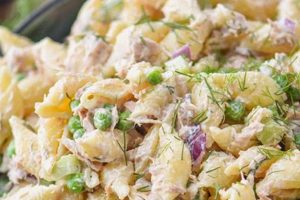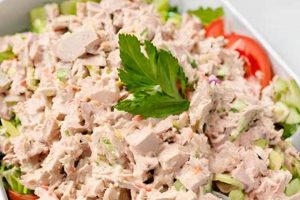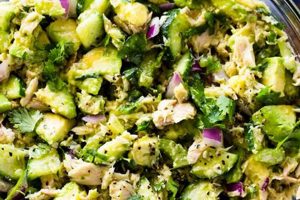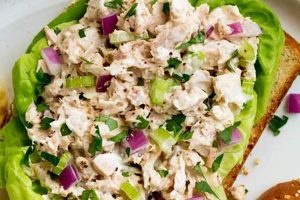Combinations of ingredients and preparation methods for creating a dish centered around canned tuna offer a versatile and adaptable meal option. For instance, a classic version might involve mayonnaise, celery, and onion, while other variations incorporate ingredients like grapes, apples, or nuts, offering a range of flavor profiles from savory to sweet.
Quick preparation, affordability, and high protein content make tuna-based dishes a practical and nutritious choice. Historically, the popularity of these dishes increased with the rise of canned food in the early 20th century, providing a convenient and shelf-stable protein source. This accessibility contributed to the proliferation of diverse regional and cultural variations.
This exploration will delve into a variety of preparations, considering factors like dietary restrictions, flavor preferences, and creative culinary approaches. From simple, everyday lunches to more elaborate and flavorful presentations, the possibilities are vast and adaptable to individual tastes and needs.
Tips for Elevating Tuna Salad
Optimizing flavor and texture requires attention to ingredient selection and preparation techniques.
Tip 1: Quality Tuna Selection: Opting for high-quality canned tuna packed in water or oil significantly impacts the final result. Tuna packed in oil offers a richer flavor, while water-packed tuna provides a leaner option. Draining the tuna thoroughly is crucial for achieving the desired consistency.
Tip 2: Mayonnaise Enhancement: While standard mayonnaise is commonly used, experimenting with flavored mayonnaises like sriracha mayo or herb-infused mayo adds depth and complexity.
Tip 3: Freshness of Produce: Crisp, fresh vegetables such as celery, onion, and bell peppers contribute both texture and flavor. Finely dicing vegetables ensures even distribution throughout the salad.
Tip 4: Creative Ingredient Incorporation: Incorporating elements like chopped apples, grapes, or dried cranberries introduces contrasting textures and flavors, enhancing the overall sensory experience.
Tip 5: Seasoning Considerations: Classic seasonings such as salt, pepper, and a touch of Dijon mustard enhance the existing flavors. Experimentation with herbs and spices, like dill or paprika, can personalize the flavor profile.
Tip 6: Mindful Mixing Technique: Gently folding ingredients together prevents overmixing and ensures the tuna remains flaky. Overmixing can result in a mushy texture.
Tip 7: Chilling for Optimal Flavor: Allowing the salad to chill in the refrigerator for at least 30 minutes allows the flavors to meld and enhances the overall taste experience.
Attention to detail in ingredient selection, preparation, and flavor combinations results in a superior culinary outcome. By employing these strategies, one can elevate a simple tuna salad to a more satisfying and flavorful dish.
By incorporating these suggestions, individuals can consistently produce high-quality tuna salad tailored to individual preferences.
1. Classic
Classic tuna salad represents a foundational preparation method, often serving as a starting point for more elaborate variations. Understanding the core components of this classic approach provides a valuable framework for culinary exploration and adaptation.
- Core Ingredients
Classic tuna salad typically features a limited number of key ingredients: canned tuna, mayonnaise, celery, and onion. These ingredients establish a familiar flavor profile characterized by the savory taste of tuna complemented by the creamy texture of mayonnaise and the subtle crunch of celery and onion. This simplicity allows the natural flavors of the components to shine through.
- Texture and Consistency
Achieving the desired texture involves striking a balance between the flaky nature of the tuna and the creamy consistency of the mayonnaise. The addition of finely chopped celery and onion provides a subtle textural contrast. Overmixing can lead to a mushy consistency, while undermixing may result in an uneven distribution of ingredients. The ideal texture is smooth yet retains some textural variation.
- Seasoning
Seasoning in classic tuna salad is typically understated, relying primarily on salt and pepper to enhance the existing flavors. A touch of Dijon mustard can add a subtle tang, while a squeeze of lemon juice can introduce brightness. The minimalist approach to seasoning emphasizes the natural flavors of the core ingredients.
- Serving and Presentation
Classic tuna salad is versatile in its presentation. It can be served as a sandwich filling, a salad topping, or enjoyed on its own with crackers or bread. This adaptability makes it a convenient and practical meal option for a variety of occasions. Its familiar flavor profile and ease of preparation contribute to its enduring popularity.
By understanding the principles of a classic tuna salad, one can appreciate its enduring appeal and utilize it as a springboard for creative culinary experimentation. Building upon this foundation allows for the development of more complex and nuanced flavor profiles while maintaining the essential characteristics that define this timeless dish.
2. Mediterranean
The “Mediterranean” designation, when applied to tuna salad, signifies the incorporation of ingredients and flavor profiles characteristic of the Mediterranean region. This culinary influence manifests primarily through the inclusion of ingredients such as olives, feta cheese, capers, red onion, and a lemon-herb vinaigrette. The resulting flavor profile offers a departure from the traditional mayonnaise-based preparation, emphasizing brighter, more acidic notes complemented by the salty, briny character of olives and capers. The use of fresh herbs like oregano, dill, and mint further enhances the Mediterranean character. An example of this influence is observed in recipes featuring Kalamata olives, crumbled feta, chopped red onion, and a dressing of lemon juice, olive oil, and oregano. This combination creates a lighter, more refreshing tuna salad compared to its classic counterpart.
The practical significance of understanding this connection lies in the ability to create a tuna salad variant that aligns with specific dietary preferences or health goals. The Mediterranean diet, known for its emphasis on fresh produce, healthy fats, and lean protein, provides a framework for crafting a nutritious and flavorful tuna salad. Substituting a lemon-herb vinaigrette for mayonnaise reduces the overall fat content while enhancing the flavor profile with fresh, vibrant notes. The inclusion of ingredients like olives and capers adds antioxidants and healthy fats. Furthermore, the Mediterranean approach offers an opportunity for culinary creativity, allowing for the exploration of diverse flavor combinations and textures beyond the traditional paradigm. This adaptability makes it a suitable option for individuals seeking variety and flavor complexity in their meals.
In summary, the Mediterranean influence on tuna salad introduces a distinctive flavor profile characterized by brightness, acidity, and briny notes. This approach offers a healthier alternative to traditional preparations while also providing a platform for culinary innovation. By understanding the key components and flavor principles of Mediterranean cuisine, individuals can craft a tuna salad that aligns with their nutritional goals and taste preferences, demonstrating the practical application of culinary knowledge in creating flavorful and healthful meals.
3. Spicy
The “spicy” descriptor, within the context of tuna salad recipes, signifies the incorporation of ingredients intended to elicit a sensation of heat or piquancy. This effect is typically achieved through the addition of chili peppers, hot sauces, or spices like cayenne pepper or paprika. The perceived “heat” results from the interaction of capsaicinoids, chemical compounds found in chili peppers, with sensory receptors in the mouth and throat. The intensity of the spicy sensation is influenced by the specific type and quantity of chili pepper used. For instance, incorporating jalapeos into a tuna salad recipe introduces a moderate level of heat, while habaneros deliver a significantly more intense experience. Similarly, the choice between fresh, dried, or pickled peppers can influence both the flavor profile and the level of spiciness.
The integration of spicy elements offers several advantages. It can elevate a simple tuna salad by adding complexity and depth of flavor. The heat can counterbalance the richness of mayonnaise or the fattiness of the tuna, creating a more balanced flavor profile. Moreover, the inclusion of spices offers potential health benefits. Capsaicinoids, for instance, are associated with anti-inflammatory and metabolic properties. From a culinary perspective, understanding the nuances of spice allows for customization. One can adjust the level of heat to cater to individual preferences, ranging from a subtle warmth to a fiery intensity. The choice of spicy ingredient also influences the overall flavor profile. Jalapeos, for example, contribute a bright, vegetal flavor, while chipotle peppers offer a smoky complexity.
In summary, the “spicy” element in tuna salad recipes provides a mechanism for enhancing flavor complexity, introducing potential health benefits, and catering to individual preferences. Careful selection and application of spicy ingredients allow for a tailored culinary experience, demonstrating the practical significance of understanding spice within the broader context of tuna salad preparation.
4. Fruity
The incorporation of fruit into tuna salad introduces a dimension of sweetness and textural contrast, expanding the traditional savory profile. This approach offers a refreshing alternative to classic preparations, appealing to those seeking a lighter, more nuanced flavor experience. The strategic use of fruit complements the savory base of tuna and mayonnaise, creating a balanced and complex dish. This exploration delves into the facets of incorporating fruit into tuna salad, highlighting the interplay of flavors, textures, and culinary possibilities.
- Fruit Selection
The choice of fruit significantly influences the final flavor profile. Apples, grapes, and cranberries are common additions, each contributing a distinct characteristic. Apples provide a crisp, tart counterpoint, while grapes offer juicy sweetness. Dried cranberries introduce a chewy texture and concentrated sweetness. Tropical fruits like mango or pineapple can also be incorporated, adding a vibrant, tangy dimension. The selection process should consider the desired level of sweetness, acidity, and textural contrast.
- Balancing Flavors
Achieving a harmonious balance between the savory and sweet elements is crucial. The inherent sweetness of the fruit should complement, not overpower, the savory notes of the tuna. A touch of acidity, often achieved through lemon juice or vinegar, can bridge the gap between these contrasting flavors. The quantity of fruit used plays a vital role in maintaining this balance. Overuse can result in an overly sweet salad, while insufficient fruit may not provide the desired contrasting flavor.
- Textural Considerations
Fruit introduces textural variety to tuna salad. The crispness of apples, the juiciness of grapes, and the chewiness of dried fruit create a dynamic interplay of textures. This contrasts with the typically soft consistency of traditional tuna salad, offering a more engaging sensory experience. The size and shape of the fruit pieces also contribute to the overall texture. Finely diced fruit integrates seamlessly, while larger chunks provide more pronounced textural contrast.
- Complementary Ingredients
Fruit often pairs well with other ingredients that enhance the overall flavor profile of the tuna salad. Nuts, such as walnuts or pecans, add a crunchy texture and earthy flavor that complements the sweetness of the fruit. Fresh herbs, like mint or dill, can introduce a refreshing element. These additions create a more complex and nuanced flavor profile, elevating the tuna salad beyond a simple combination of ingredients.
The integration of fruit into tuna salad expands the culinary possibilities of this versatile dish. By understanding the interplay of fruit selection, flavor balance, textural considerations, and complementary ingredients, one can craft a tuna salad that offers a refreshing and nuanced departure from traditional preparations. This approach highlights the potential for culinary creativity within the seemingly simple framework of tuna salad.
5. Asian-inspired
The “Asian-inspired” designation, applied to tuna salad, signifies the incorporation of ingredients and flavor profiles characteristic of various Asian cuisines. This influence manifests through ingredients like soy sauce, ginger, sesame oil, sriracha, rice vinegar, and seaweed. The resulting flavor profile often features umami richness from soy sauce, a bright, tangy acidity from rice vinegar, and the subtle heat of ginger or sriracha. Sesame oil contributes a nutty aroma and flavor. Seaweed, such as wakame or nori, adds a distinct oceanic note and textural complexity. An example of this fusion is observed in recipes featuring tuna, mayonnaise, shredded carrots, chopped scallions, soy sauce, sesame oil, and a touch of ginger. This combination creates a savory, umami-rich tuna salad distinct from traditional Western preparations.
Understanding this fusion allows for creative exploration and adaptation of culinary traditions. Asian cuisines offer a diverse range of flavors and ingredients, enabling customization and personalization of tuna salad. The substitution of traditional mayonnaise with a mixture of mayonnaise and Greek yogurt, combined with the addition of sriracha and chopped cilantro, demonstrates the adaptability of this concept. The resulting dish offers a lighter, spicier, and more nuanced flavor profile compared to classic mayonnaise-based versions. Furthermore, exploring Asian-inspired variations promotes culinary awareness and appreciation for diverse cultural influences. It provides a platform for experimentation and the discovery of new flavor combinations, expanding the culinary repertoire beyond familiar Western tastes.
In summary, the Asian influence on tuna salad introduces a distinctive flavor profile characterized by umami, tanginess, and often a touch of heat. This approach offers a departure from traditional preparations and encourages culinary exploration. Understanding key Asian ingredients and flavor principles allows for customized and creative variations, enriching the culinary experience and fostering a deeper appreciation for global food traditions.
6. Diet-friendly
The intersection of “diet-friendly” and “tuna salad recipe ideas” represents a significant area of culinary adaptation, driven by the increasing prevalence of specific dietary needs and health-conscious consumers. This connection necessitates modifications to traditional recipes, focusing on ingredient substitutions and portion control to align with various dietary restrictions and health goals. Cause and effect relationships are evident; specific dietary requirements, such as low-sodium, low-fat, or gluten-free diets, directly influence recipe modifications. For instance, a low-sodium diet necessitates using low-sodium tuna and minimizing added salt, impacting the overall flavor profile. Similarly, accommodating gluten-free diets requires choosing gluten-free bread or crackers for serving. The “diet-friendly” component becomes central to recipe development, influencing ingredient selection, preparation methods, and portion sizes. Real-life examples include using Greek yogurt instead of mayonnaise to reduce fat content, incorporating more vegetables to increase fiber intake, or opting for whole-wheat bread for added nutritional value.
Practical applications of this understanding are diverse. Individuals managing health conditions like diabetes or hypertension can adapt tuna salad recipes to control carbohydrate and sodium intake, respectively. Weight management goals often necessitate portion control and the selection of low-calorie ingredients. Catering to specific dietary restrictions, such as gluten intolerance or lactose intolerance, demands careful ingredient selection and substitutions. For instance, a gluten-free tuna salad might be served on lettuce wraps or gluten-free bread, while a dairy-free version would omit traditional mayonnaise or utilize a dairy-free alternative. Understanding the “diet-friendly” aspect also facilitates creative culinary adaptations. Traditional ingredients can be replaced with healthier alternatives without compromising flavor or satisfaction. For example, avocado can replace mayonnaise for a creamy, healthy fat source, while chickpeas can add protein and fiber. These adaptations demonstrate the versatility of tuna salad as a base for creating meals tailored to individual dietary needs.
In summary, the “diet-friendly” attribute plays a crucial role in shaping tuna salad recipe ideas. Dietary restrictions and health goals directly influence ingredient selection, preparation methods, and portioning. This understanding empowers individuals to adapt recipes, promoting healthier eating habits without sacrificing flavor or satisfaction. Challenges may include balancing flavor complexity with dietary limitations, but the versatility of tuna salad allows for creative solutions, ensuring a satisfying and health-conscious culinary experience. This adaptability aligns with the broader trend toward personalized nutrition and underscores the importance of culinary knowledge in managing health and well-being.
7. Sandwich fillings
The relationship between sandwich fillings and tuna salad recipe ideas is fundamental, with tuna salad serving as a versatile and popular filling option. The adaptability of tuna salad to various bread types and accompaniments contributes to its widespread use in sandwiches. Specific recipe variations directly influence the final sandwich construction. For instance, a chunky tuna salad, incorporating larger pieces of vegetables or fruit, may necessitate a sturdier bread choice compared to a smoother, more finely chopped variation. Similarly, the flavor profile of the tuna salad influences complementary ingredients within the sandwich. A spicy tuna salad might pair well with cooling elements like lettuce and tomato, while a Mediterranean-inspired version might benefit from the addition of cucumbers and feta cheese. Real-life examples include classic tuna salad sandwiches on white or wheat bread, open-faced tuna melts on rye, and wraps filled with tuna salad and mixed greens.
Practical applications of this understanding extend to menu planning, recipe development, and culinary creativity. Considering the interplay between tuna salad variations and sandwich construction allows for customized and flavorful meal options. Dietary considerations also play a role; a diet-friendly tuna salad, featuring reduced-fat mayonnaise and whole-wheat bread, contributes to a healthier sandwich option. Furthermore, understanding the textural and flavor dynamics within a sandwich allows for enhanced culinary experiences. Balancing creamy tuna salad with crisp vegetables or crunchy nuts adds textural complexity. Contrasting flavors, such as spicy tuna salad with sweet fruit or tangy pickles, create a more nuanced and satisfying sandwich. Creative variations, like incorporating different types of bread, cheeses, or spreads, further expand the possibilities within this simple framework.
In summary, tuna salad functions as a versatile and adaptable sandwich filling, with recipe variations influencing bread choice, complementary ingredients, and overall sandwich construction. This understanding facilitates personalized meal creation, catering to individual dietary needs and flavor preferences. Challenges may arise in balancing textures and flavors to achieve a cohesive and satisfying sandwich, but the adaptability of tuna salad allows for creative solutions. This relationship highlights the essential role of fillings in sandwich construction and underscores the importance of considering flavor profiles, textures, and dietary considerations when crafting a complete and balanced meal.
Frequently Asked Questions
This section addresses common inquiries regarding the preparation and consumption of tuna salad.
Question 1: How long can tuna salad be stored safely?
Prepared tuna salad should be refrigerated and consumed within three to five days for optimal quality and safety. Storage beyond this timeframe increases the risk of bacterial growth.
Question 2: Can tuna salad be frozen?
Freezing tuna salad is not generally recommended. The mayonnaise-based dressing can separate and become watery upon thawing, resulting in an undesirable texture. Freezing can also negatively impact the flavor and freshness of the ingredients.
Question 3: What are common signs of spoiled tuna salad?
Indicators of spoilage include a sour or unpleasant odor, a slimy texture, and discoloration. If any of these signs are present, the tuna salad should be discarded immediately.
Question 4: How can the sodium content in tuna salad be reduced?
Using low-sodium canned tuna, rinsing the tuna under cold water before mixing, and minimizing added salt in the recipe can effectively reduce the overall sodium content. Incorporating fresh herbs and spices can enhance flavor without relying on excess salt.
Question 5: What are healthy alternatives to mayonnaise in tuna salad?
Greek yogurt, mashed avocado, or a combination of the two offer healthier alternatives to traditional mayonnaise, reducing fat and calorie content while maintaining a creamy texture. These substitutes also provide additional nutritional benefits.
Question 6: How can tuna salad be made more flavorful without adding excess calories?
Incorporating fresh herbs, spices, lemon juice, or vinegar can significantly enhance the flavor profile of tuna salad without adding substantial calories. Chopped vegetables, such as bell peppers, onions, or celery, add flavor, texture, and nutritional value.
Careful attention to food safety practices, ingredient selection, and recipe modifications can optimize the quality and nutritional value of tuna salad.
This concludes the frequently asked questions section.
Tuna Salad Recipe Ideas
Exploration of this subject reveals a remarkable versatility, adaptable to a wide spectrum of flavor profiles and dietary preferences. From classic preparations emphasizing simplicity to innovative variations incorporating diverse cultural influences, the potential for culinary creativity is vast. Considerations regarding ingredient selection, flavor balance, textural elements, and dietary modifications contribute to a comprehensive understanding of crafting exceptional tuna salad. Emphasis on freshness, quality ingredients, and mindful preparation techniques consistently yields superior results.
Culinary experimentation within this seemingly simple framework offers opportunities for continuous discovery and personalized culinary expression. The adaptability of tuna salad to diverse palates and dietary needs solidifies its enduring presence in culinary traditions worldwide. Further exploration and refinement of these concepts promise continued evolution and enjoyment of this versatile dish.






